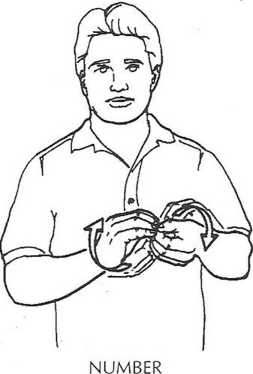Obraz (82)

The Concept of Skquentiali'iy in the Dkscription of Signs ' 31



FIGURĘ 14. Signs that have the same handshape, according to Stokoe's system.
In the Stokoe system, a sequence of two movements is shown in the movement part of the trąnicription. The sign MILLION would be written as follows:
MILLION BO.B*-*
This notation means that the bent B handshape of the active hand (B) contacts the base hand (palm up, Ba) once in a sharp movement (x) and then moves away from the signer (-l) and repeats the contacting movement (x). The sequence of move-ments, then, is represented as *- *. In the Stokoe system, when there is a sequence of handshapes, orientations, or locations, the change is shown in the movement por-tion. For example, UNDERSTAND has two handshapes, X and G (in the Stokoe system), and the second handshape is shown with the movement
nXTntGi
This notation means that the handshape X moves toward the signer (t) at the fore-head (n) and that there is an opening action (□) that results in the handshape G.
The sequence of orientation in the sign DIE is shown in the movement
BdBGd
This notation means that one hand begins with the palm down (BD) and the other hand begins with the palm up (Ba). In the course of producing the sign, the orientation of each hand changes so that Dbecomes a and abecomes D.
In one variant of the sign DEAF, the G handshape moves upward (A), contacts the face (x) and then moves toward the signer (t) and contacts the face again. The sign is represented as follows:
uGa*tx
So the sequence of locations is shown by xyx
It is not that the Stokoe system ignores sequences of handshapes, locations, and orientations. These sequences are seen as a function of the movement component. It is essential to understand that in Stokoe s system these sequences are seen as
Wyszukiwarka
Podobne podstrony:
49240 scan0015 (8) 344 HANDBOOK OF ECOTOXICOLOGY Naphthalene Figurę 14.2 Examples of PAH compounds w
Obraz (80) UNIT 3The Concept of Seąuentiality in the Description of Signs ~)GOAL To explain why sequ
Obraz (84) 33 The Concept of Sequentialpiy in the Dkscription of Signs CHILDREN, the palm orientatio
15193 Obraz (83) unimportant in the description of signs. W hat this means is that he proposed a str
189 • nik On the basis of an analysis of the formulations utilizing the concept of the commu-■ js cl
Figurę 19.3 The concept of adding layers of geographic Information (e.g., that stored in different m
8 Anna ZąbkowiczMarket Effectiveness vs. Capability of State.Abstract The concept of effective marke
więcej podobnych podstron